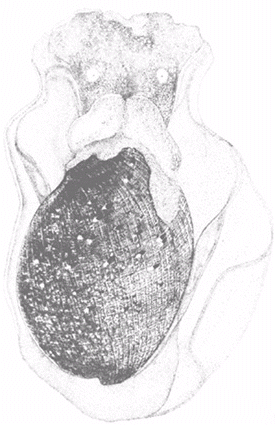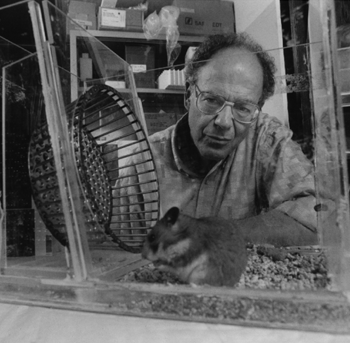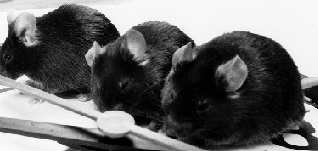
THE CLOCK IN OTHER ORGANISMS...
Non-human Animals
Research in the area of biological clocks did not begin with humans. Early
research was done on a variety of animals including rats, hamsters, sparrows,
lizards, marine snails, and fruit flies. The choice of an animal depended on
many considerations--size, rate of reproduction, expense to maintain, and
availablity--as well as behavioral issues, such as whether it entrained easily
and what environmental factors seemed to affect its behavior.
 House sparrows were one of the first
animals in which the biological clock was anatomically localized [23]. The
sparrow's clock is believed to consist of the suprachiasmatic nucleus (SCN),
as in humans, and the pineal gland. In this circadian system, photoreceptors
are found in the retina as well as in the pineal gland and in the deep brain.
Investigators are clarifying the relationship between the sparrow's two clocks
and its photoreceptors [24].
House sparrows were one of the first
animals in which the biological clock was anatomically localized [23]. The
sparrow's clock is believed to consist of the suprachiasmatic nucleus (SCN),
as in humans, and the pineal gland. In this circadian system, photoreceptors
are found in the retina as well as in the pineal gland and in the deep brain.
Investigators are clarifying the relationship between the sparrow's two clocks
and its photoreceptors [24].
Although sparrows are similar to humans, how do they compare with
other
vertebrates such as reptiles? Reptiles also have photoreceptors in the eye,
the pineal and in the deep brain. Most reptiles and some amphibians, however,
also have photorecptors in the parietal eye, an unseeing third eye located on
the top of the skull with a well-defined retina, lens, and cornea that is
known to play a role in thermoregulation and photoperiodism
in some species [25]. In reptiles and other lower vertebrates, the pineal
gland synthesizes information from the photoreceptors and in turn secretes
melatonin in a rhythm which synchronizes other parts of the clock system. The
role of the SCN in lower vertebrates is unclear, but it is thought to contain
another part of the clock.

One of the most intensively studied invertebrates is Drosophila, the
familiar fruit fly. This insect reproduces quickly, is economical to raise,
requires very little space, and has an extensively mapped genome. Locomotor
activity is difficult to observe in individual flies, but the eclosion
rhythm, which is under clock control, can be observed in large numbers
of flies [23].
Mutant strains of flies are presently being used to discover more about the
molecular basis of the clock.
The biological clock has been found in the optic lobe in other
invertebrates, such as cockroaches, crickets and silkmoths [23]. Mollusks
seem to have a clock only in the eyes. Two types of mollusks, a marine snail
(Bulla gouldiana),  pen & ink
of Bulla by Donna Bennet
pen & ink
of Bulla by Donna Bennet
and the sea hare (Aplysia californica), have large neurons that can be
individually studied [see review by 23]. Furthermore, isolated retinal
neurons
can even be placed in vitro , and still exhibit circadian rhythms in
their electrical behavior.
 The most
widely
studied mammals are rats, mice, and hamsters. All of these rodents have
clearly defined circadian rhythms measured as the onset of their daily
locomotor activity. Hamsters, for example, are nocturnal and will become
active at a certain time every night. This rhythm can be quantified by
recording their activity on a running wheel which is connected to a computer
that converts the raw data into an actogram.
The most
widely
studied mammals are rats, mice, and hamsters. All of these rodents have
clearly defined circadian rhythms measured as the onset of their daily
locomotor activity. Hamsters, for example, are nocturnal and will become
active at a certain time every night. This rhythm can be quantified by
recording their activity on a running wheel which is connected to a computer
that converts the raw data into an actogram.
The SCN was first identified as a circadian clock in rats. When
Richter lesioned the rat SCN, the animals' locomotor activity became
arrhythmic.
This experiment was soon followed by a series of investigations in other
rodents and mammals on how SCN lesions can affect circadian rhythms [23].
Late in the 1980's a spontaneous mutation, later named the
tau
mutant, was discovered in a colony of golden hamsters. The period of the
mutant's rhythm was noticeably shorter than the 24-hour norm: heterozygous
tau mutants had approximately 22-hour periods, and homozygous
ones had a 20-hour
cycle. When normal hamsters who
had been made
arrhythmic by a SCN lesion were given a transplanted tau SCN, they
resumed a circadian rhythmicity that matched that of the donor. This
experiment was also repeated in reverse, with the tau hamster showing a
normal hamster's 24-hour rhythm after receiving a normal hamster's SCN.
These experiments
provided the final proof that the SCN is the
site of a clock in mammals [26].

Center researcher
Mike Menaker observes the
behavior of a tau mutant
 A similar mutant gene
(clock) that causes a longer than normal period of running wheel
behavior was recently found in mice. This discovery is exciting because mice
have a well-mapped genome. Investigators hope to
use hamster and mouse mutants
to identify the clock's internal mechanisms and determine at the
genetic level
what makes it "tick".
A similar mutant gene
(clock) that causes a longer than normal period of running wheel
behavior was recently found in mice. This discovery is exciting because mice
have a well-mapped genome. Investigators hope to
use hamster and mouse mutants
to identify the clock's internal mechanisms and determine at the
genetic level
what makes it "tick".

Accessibility statement
 House sparrows were one of the first
animals in which the biological clock was anatomically localized [23]. The
sparrow's clock is believed to consist of the suprachiasmatic nucleus (SCN),
as in humans, and the pineal gland. In this circadian system, photoreceptors
are found in the retina as well as in the pineal gland and in the deep brain.
Investigators are clarifying the relationship between the sparrow's two clocks
and its photoreceptors [24].
House sparrows were one of the first
animals in which the biological clock was anatomically localized [23]. The
sparrow's clock is believed to consist of the suprachiasmatic nucleus (SCN),
as in humans, and the pineal gland. In this circadian system, photoreceptors
are found in the retina as well as in the pineal gland and in the deep brain.
Investigators are clarifying the relationship between the sparrow's two clocks
and its photoreceptors [24].

 pen & ink
of Bulla by Donna Bennet
pen & ink
of Bulla by Donna Bennet The most
widely
studied mammals are rats, mice, and hamsters. All of these rodents have
clearly defined circadian rhythms measured as the onset of their daily
locomotor activity. Hamsters, for example, are nocturnal and will become
active at a certain time every night. This rhythm can be quantified by
recording their activity on a running wheel which is connected to a computer
that converts the raw data into an actogram.
The most
widely
studied mammals are rats, mice, and hamsters. All of these rodents have
clearly defined circadian rhythms measured as the onset of their daily
locomotor activity. Hamsters, for example, are nocturnal and will become
active at a certain time every night. This rhythm can be quantified by
recording their activity on a running wheel which is connected to a computer
that converts the raw data into an actogram.
 A similar mutant gene
(clock) that causes a longer than normal period of running wheel
behavior was recently found in mice. This discovery is exciting because mice
have a well-mapped genome. Investigators hope to
use hamster and mouse mutants
to identify the clock's internal mechanisms and determine at the
genetic level
what makes it "tick".
A similar mutant gene
(clock) that causes a longer than normal period of running wheel
behavior was recently found in mice. This discovery is exciting because mice
have a well-mapped genome. Investigators hope to
use hamster and mouse mutants
to identify the clock's internal mechanisms and determine at the
genetic level
what makes it "tick".